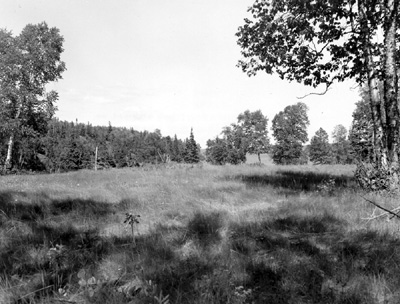
American Fur Company
History
By: Lawrence Rakestraw

American Fur Company Site at Belle Isle, 1952: Beaubien, Isle Royale National Park.
ur historic records of commercial fishing on Isle Royale begin with a venture of the American Fur Company. Ramsay Crooks, manager of the company, became interested in fishing Lake Superior for whitefish, lake trout, and siskowit. By 1834 the company started to explore the lake, and in 1836 began establishing fishing stations. Their headquarters was established at La Pointe, in the Apostle Islands, Wisconsin. Here a settlement was built, including store houses, wharfs and dwellings. Schooners were built to carry the fish to Sault Ste. Marie. Other stations were established near the main fishing grounds at Grand Marais, Grand Portage, Minnesota, Isle Royale, the Montreal River, Michigan, and at L'Anse, Michigan.
The first station on Isle Royale, established in July, 1837, was located on Belle Isle (then called Fish Island) on the site of the present campground. In September of that year Siskiwit Bay was explored, and a fishery set up on Checker Point, which became the main establishment. By 1839 there were seven centers of fishing activities on the island, with a crew of 33 fishermen. The Checker Point establishment had, in addition to the local manager, two coopers to make barrels, and seven voyageurs, employed to fish and to collect fish from the other establishments. The other stations were occupied by three to five fishermen each, and were located on Belle Isle, Merritt's Island, Grace Point, Duncan Bay, Hay Bay, and in Rock Harbor.
The establishments varied in size. The largest was at Checker Point, where there was a dwelling for the clerk, a barrack for the men, a cooper's shop, a store house, salt house, and a fish house. Most of the buildings were built of logs, roofed with the bark of birch or red cedar; but at least one was built of red sandstone. Some attempts at gardening were carried on. At Grace Point a log storehouse was built near the end of the point, and about five acres were cleared for a garden. Several fish houses dotted the shore line between Hay Bay and Spruce Point. At Rock Harbor a large storehouse was built, which was later used by the Siskowit Mining Company. The Belle Isle Station had a large log house, but settlements on the Siskiwit Islands and on the northeastern end of the Island were apparently summer camps only.
The men who fished were largely French and half-breeds. After 1839, the men were for the most part taken to La Pointe to winter, and to work in other fishing grounds during the early spring. In addition to the fishermen, hired at either an annual wage of $120 to $300, or at $4 per 200 pounds of fish, there were coopers to make the casks in which the fish were packed. Some Indian women accompanied them to clean and pack the fish. Twine nets were made at the stations, with the mesh sized differently for the different fish. Fishing was carried on from Macinac boats, barges of oak boards with flat bottom and blunt ends, and having rudder and mast. These were propelled either by oars or sail. The fish were picked up from the stations by two forty-foot schooners, the William Brewster and the Siskawit. In addition, a scow forty feet long with hold four feet high, and a capacity of 128 barrels of fish, was constructed for inshore work.
Citation:
- Rakestraw, L., United States., & Isle Royale Natural History Association. (1968). Commercial Fishing on Isle Royale -- 1800-1967. Houghton, Mich.: Isle Royale Natural History Association in cooperation with the National Park Service.